Film & Video
Film & Video
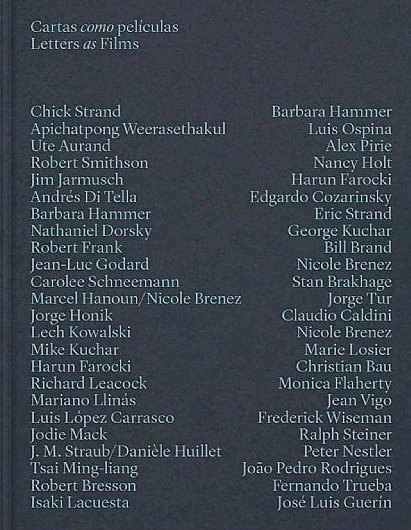
Letters As Films
Fascinating letters and ephemera from experimental filmmakers such as Maya Deren, Nathaniel Dorsky, Jim Jarmusch, Harun Farocki, Jean Vigo and more.
More than 50 postcards, manuscripts, typewritten letters and even emails are presented alongside stills, drawings and storyboards to create a stunning epistolary archive many years in the making. Curator and Punto de Vista International Documentary Film Festival director Garbiñe Ortega has compiled these materials in an effort to "create echoes and reverberations between materials which, as in a film, thanks to the editing, take on another meaning beyond their specific content."
The volume includes correspondence exchanged among filmmakers Jodie Mack, Jonas Mekas, Stan Brakhage, Jorge Honik, Claudio Caldini, Lech Kowalski, Nicole Brenez, Marcel Hanoun, Nathaniel Dorsky, George Kuchar, Nazli Dinçel, Norman McLaren, Maya Deren, Jean Vigo, Richard Leacock, Monica Flaherty, Richard Linklater, Gabe Kingler, Robert Breer, Robert Smithson, Nancy Holt, Fernando Trueba, Jean-Marie Straub, Jim Jarmusch, Hanun Farocki, Robert Frank, Fred Wiseman, Margaret Tait, Ute Aurand, Terrence Malick, Lynne Sachs and Gunvor Nelson.
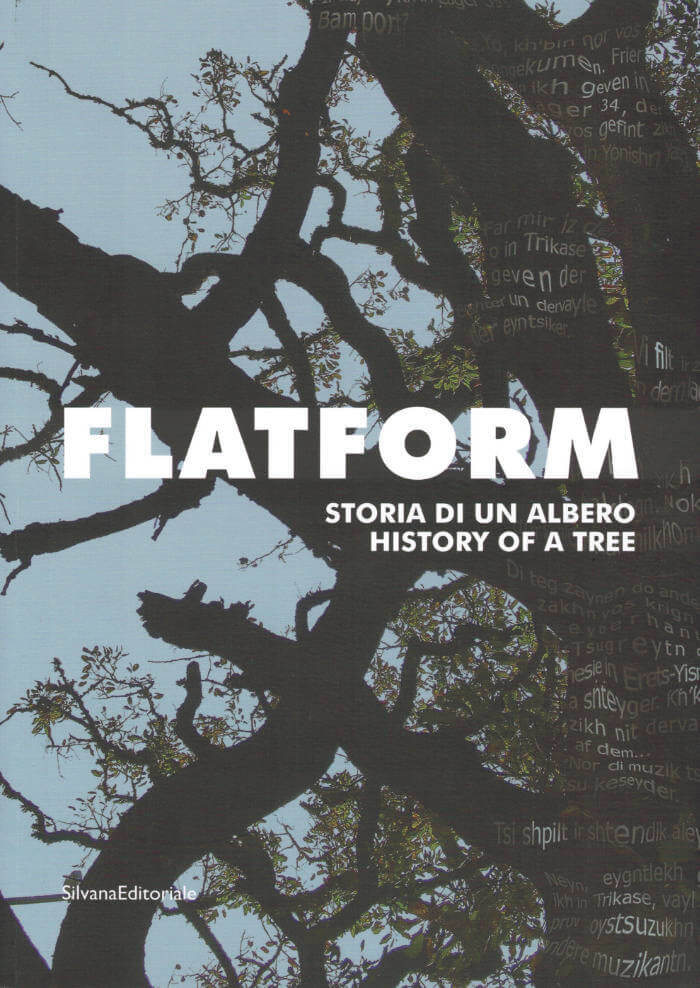
History Of A Tree
In a reality in which the boundaries between cinema, art, installation and multimedia experimentation seem to be increasingly blurred, History of a Tree by Flatform is a project that sets out to radically alter the idea of the portrait in western art.
A non-human living organism – the Oak of the Hundred Knights of Tricase, the oldest Vallonea oak in Europe at the age of 900 years – and the territory in which it has stood for centuries become the subject: through a film and a robotized video installation, statements become a portrait, and are transformed into a work of art.
The book retraces the genesis, development and implementation of this original idea, providing a visual score, the film in 80 images, dialogues in ten languages, the contributions of a tree searcher, an art historian and two philosophers, as well as a series of in-depth essays drawing on the fields of science, history, anthropology, music and linguistics.

Fantomas - Filmkritisch Tijdschrift #1
Bart Versteirt, Bjorn Gabriels and 1 more
#1 het geheugen en de herinnering
Het verleden is nooit dood. Het is niet eens verleden tijd. Die memorabele gedachte van William Faulkner spookt bij uitstek door elk bewegend beeld. In zijn meest oorspronkelijke vorm is film niet minder dan gestolde tijd, uitgekristalliseerd in 24 beelden per seconde. De filmgeschiedenis is dooraderd met werken waarvan de vertelling in de herinnering duikt, of waarin de herinnering opduikt in de vertelling; talloze cineasten – van gisteren, vandaag en morgen – maken van het geheugen hun ontginningsterrein. Met twaalf essays onderzoeken we de veelvormige wijzen waarop cineasten, archivarissen, filmhistorici, critici en kijkers de brug slaan tussen verleden, heden en toekomst.

My Mother Laughs
First published in France in 2013, My Mother Laughs is the final book written by the legendary and beloved Belgian artist and director Chantal Akerman (1950-2015) before her death. A moving and unforgettable memoir, the book delves deeply into one of the central themes and focuses of Akerman's often autobiographical films: her mother, who was the direct subject of her final film No Home Movie (2015).
With a particular focus on the difficulties Akerman faced in conjunction with the end of her mother's life, the book combines a matter-of-fact writing style with family photographs and stills from her own films in order to better convey the totality of her experience. Akerman writes: With pride because I finally believed in my ability to say something that I'd had trouble saying. I told myself, I am strong for once, I speak. I tell the truth.
Chantal Akerman (1950-2015) was a Belgian film director, screenwriter, artist and professor. She is best known for her film Jeanne Dielman, 23 quai du Commerce, 1080 Bruxelles (1975), which was dubbed a masterpiece by the New York Times. During her 42 years of active filmmaking, Akerman's influence on queer, feminist and avant-garde cinema remains unmatched, her films highlighting a near-physical passage of time. Akerman's films have been shown at the Venice Film Festival, Cannes Film Festival and the New York Film Festival, among many others.
Translated by Corina Copp.
Published June 2019.
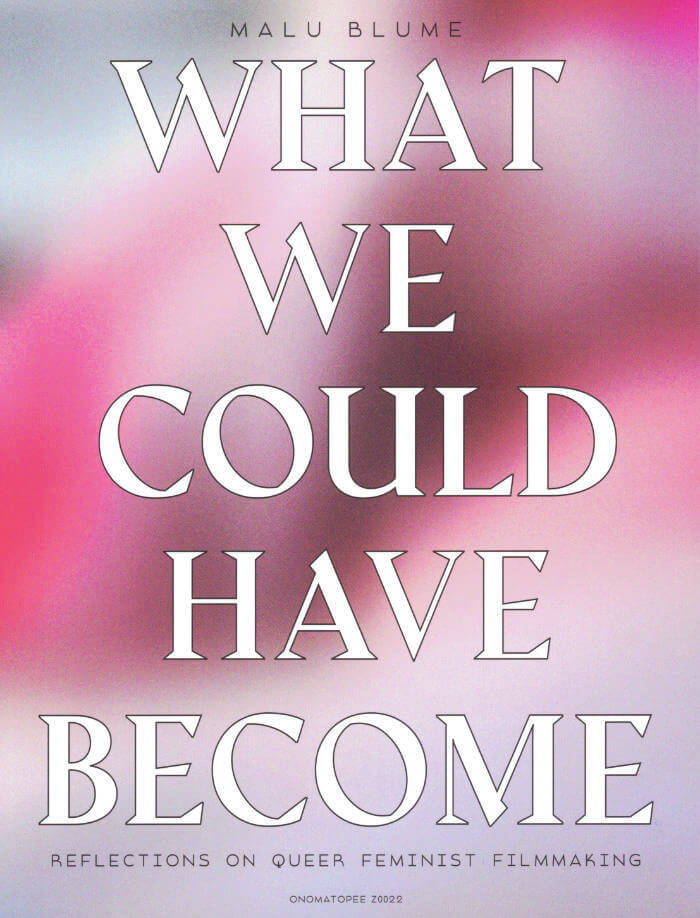
What We Could Have Become
The publication 'What we could have become: Reflections on queer feminist filmmaking' explores the radical potentials of care and speculative fiction in the context of queer feminist collective filmmaking. Departing from the experimental short film The Book of S of I (2020) by Malu Blume, this publication is a documentation of the film project just as much as its own artistic medium. Using a performative mode, it weaves together film stills with unreleased set photography, creating a visual narration that reflects caring and kinship through a queer feminist – and femme – lens.
With a foreword by editor Sascia Bailer, the booklet contains a transcript of the film’s narrative voice over and an essay on queer utopian care in the context of The Book of S of I and its making, both written by the artist Malu Blume. The publication concludes with a conversation between Malu Blume and their co-producers, friends and artistic collaborators Ipek Hamzaoglu, Laura Nitsch and Sophie Utikal, moderated by Sascia Bailer. In this conversation the artists and discuss the chances and challenges of collective film making in the context of producing The Book of S of I.
Malu Blume is a Berlin-based artist who works at the intersections of art, performance, film and education. In 2016 they completed a master's degree in Critical Studies at the Academy of Fine Arts Vienna. Malu Blume has been the co-founder and member of several collective projects on queer feminism, archival politics, friendship and collaborative knowledge production.

Atlas Europe Square
Atlas Europe Square documents a body of work by Swiss artist Yves Mettler who, since 2003, has engaged in an ongoing mapping and documentation of these sites, along with a series of projects triangulating between particular squares, interrogating their differing architectural, environmental, and public functions, and what they tell us about the ideality of ‘Europe’ and the (im)possibility of its concrete instantiation.
Here this work is extended into reflections on the relationship between art and public space, site-specificity, and the artist’s own implication in the imaginary of Europe as he becomes enmeshed in a network of projects, funds, and public bodies that seek to promote ‘European culture’ through art.
With contributions by Reza Negarestani, Laurent Thévenot, Teresa Pullano, Stephen Zepke, Neil Brenner.
Published September 2021

Sisters of the Wind
Sisters of the Wind is the fruit of artistic research on witches, ecofeminism, and science-fiction carried out between 2018 and 2021 by Juliette Lizotte aka jujulove. It is a story that weaves through seven videos and can be experienced in different ways: an interactive audiovisual performance, an online world-building workshop and role play session, and this publication!
The publication concludes the three world-building workshops and role play sessions part of the project which took place online in February 2021 due to the COVID-19 pandemic, though they were originally intended to unfold in the form of live action role play (larp). This new constraint led us to perform the worldbuilding and role play exercises in an etherpad, an open source digital tool for co-writing text in real-time. The outcome of these sessions was archived and used as material for the publication.
This "choose-your-own adventure" story consists of three parallel worlds that were co-created during three sessions, each lasting three hours. The core of the story was similar, but the direction the sessions took were quite unique. As the story unfolds, you are asked to make decisions to travel from one world to another: creating your own version of the story by following your instinct or challenging your impulses!
Sisters.°·
The wind is returning, as it always does. Sometimes it blows so hard that it carries artifacts away from the cities it tore apart, seeds from far away places, trees that didn’t have enough time to grow stronger... That’s why you always seek a protected area to settle in, relocating as the wind comes and goes in waves. You are witches. You pay attention to the world and try to make sense of this life together through the phases of the moon from maiden to mother to crone. In your community, the feminine spirit dominates, and all gender expressions are celebrated. When your precarious life is threatened by an unsettling prophecy announcing a deadly wind that will prepare the earth for a new cycle, will you go on a journey to find the source of this wind? What will you discover on the way? How will this transform you, your sisters, and the earth forever?
Edition of 100 published by Office of Metaphors, printed in Riso in May 2021 in Amsterdam.

Tell It to the Stones
Danièle Huillet and Jean-Marie Straub remembered quite well their first meeting in Paris in November 1954, “because that was when the Algerian Revolution began.” They often recalled this date, one that was the beginning of their fifty-year collaboration still considered to be one of the most radical and controversial oeuvres in modern cinema.
Tell It to the Stones presents artistic and intellectual responses to Huillet and Straub’s filmmaking methods and body of work. The book stems from a prolonged public program presented at the Akademie der Künste, Berlin, consisting of concerts, public conferences, a three-month exhibition, and a complete cinema retrospective.
Contributing artists, scholars, filmmakers, and writers, some of whom were long-time collaborators of Straub and Huillet, as well as younger artists and writers from various disciplines call upon this collective experience in new texts, revised transcripts, conceptual essays, and visual montages—taking seriously what Huillet once requested from the audience: “to help us build the in-between.” This volume is not only concerned with a general appreciation of Straub and Huillet’s cinema practice but also recognizes their substantial contributions to other arts and political thought. Presented are new readings of their literary references―Sophocles, Hölderlin, Mallarmé, Kafka, Pavese, and Brecht, among others—and also musicological and philosophical reflections on their preoccupation with Arnold Schoenberg; essayistic excursions to sites of their films; critical acclaim of their unflinching yet often misunderstood political stances; close readings of some of their most influential and radical films enriched by insights into the processes of their production. Tell It to the Stones reanimates these encounters and emphasizes how Straub and Huillet’s oeuvre still matters today, perhaps more than ever.
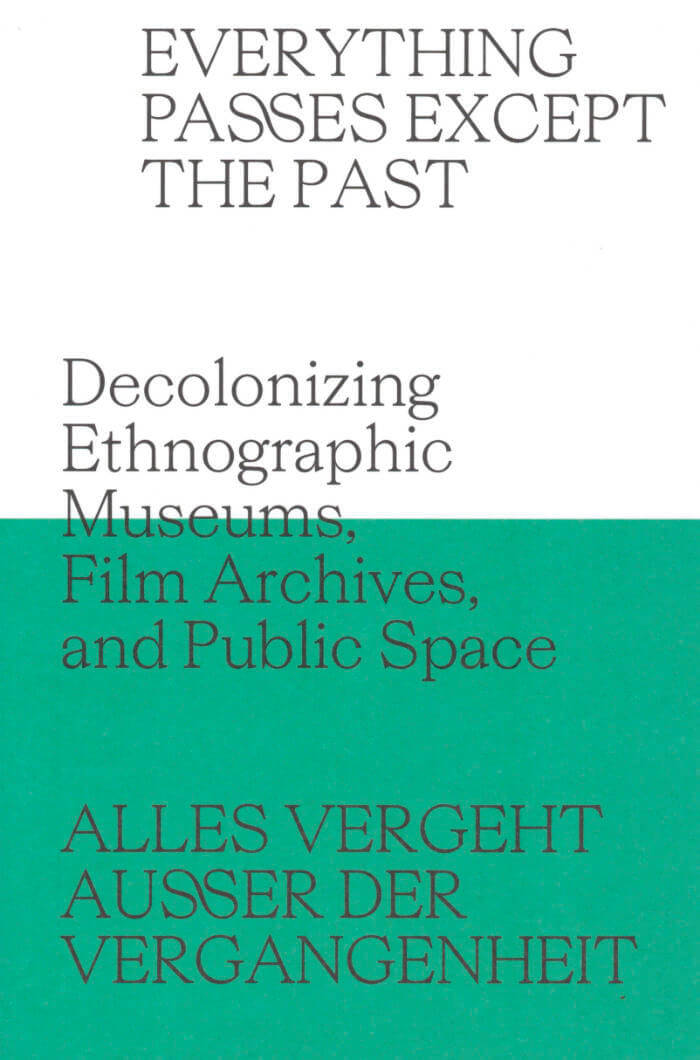
Everything Passes Except the Past – Decolonizing Ethnographic Museums, Film Archives, and Public Space
Everything Passes Except the Past takes an artistic and discursive approach to coming to grips with a colonial past that remains present in ethnographic museums, public space, and image archives.
The contributions in this book propose visionary theoretical, practical, and ethical foundations for future museums based on artistic and curatorial remediation of ethnographic collections. They also cover the role of colonial films in our collective and national memory, as well as the challenges and perspectives of tearing down or replacing monuments and renaming streets.
Contributions by Yaa Addæ Nantwi, Lotte Arndt, Andrés Antebi Arnó, Bianca Baldi, Daniel Blaufuks, Filipa César, Didi Cheeka, Clémentine Deliss, Karfa Diallo, Sally Fenaux Barleycorn, Alessandra Ferrini, Fradique, Pablo Gonzáles Morandi, Guido Gryseels, Jana J. Haeckel, Didier Houénoudé, Duane Jethro, Christian Kopp, Yann LeGall, Alberto López Bargados, Eloy Martín Corrales, Grace Ndiritu, Inês Ponte, Linda Porn, Tamer El Said, Bénédicte Savoy, Stefanie Schulte Strathaus, Mnyaka Sururu Mboro.
Graphic design: Caroline Wolewinski.
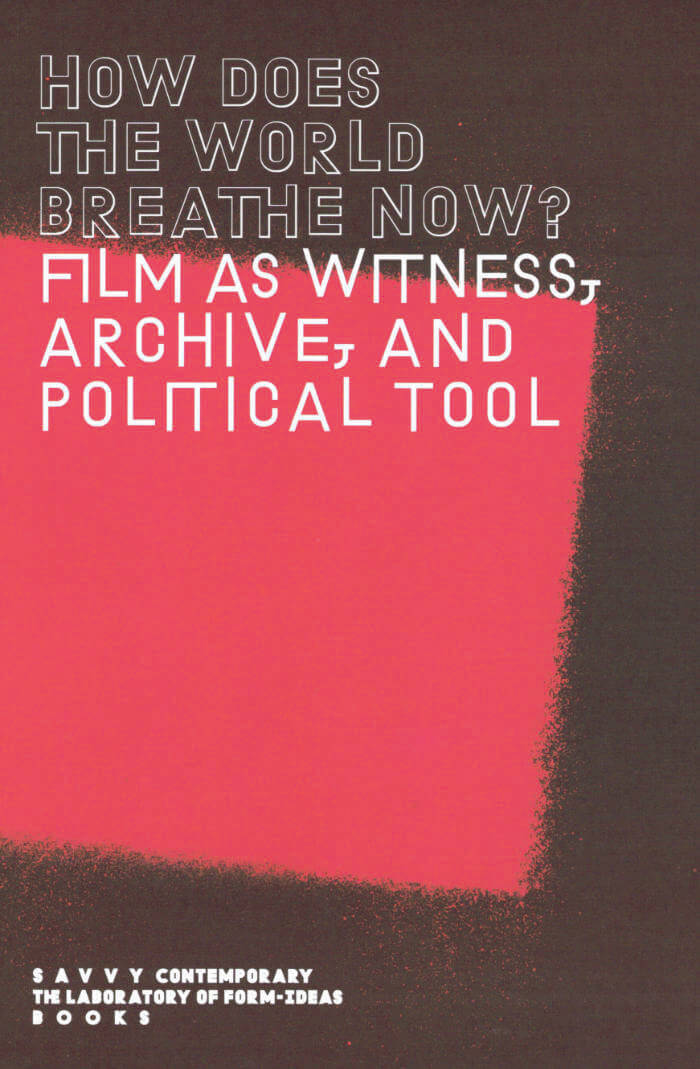
How Does The World Breathe Now? – Film as Witness, Archive, and Political Tool
Eirini Fountedaki, Pia Chakraverti-Würthwein
How film may be a constructive tool to examine the state of the world and its cruelties, and how to form a more stable and supportive culture of film production and distribution.
Out of frustration and exasperation with the state of the world in 1960, Indonesian poet Willibrordus Surendra Broto Rendra asked himself: "How does the world breathe now?"
The film series conceived of by SAVVY Contemporary, which ran from September 2016 through March 2018, was a response to our own dismay at the continued injustices that the world faces. Each week SAVVY invited a different speaker who would choose a film that she or he felt answered, or asked more questions of, the question, "how does the world breathe now?" More than just a series of screenings, the film series became a kind of ciné-club where we also ate, drank, and danced together, and out of which new concepts, collaborations, and polemics emerged. With this publication we hope to offer readers another mode of thinking about films, and to pick up on some loose threads or unfinished conversations of the film series.
Over the course of the publication's three sections: Bearing Witness: old & new filmic practices with political clout; Archiving, Preserving, and Accessing Film; and New Relationships, New Practices: Towards sustainable & ethical filmmaking, SAVVY brings together the voices of contributors such as Sarah Maldoror, Filippos Koutsaftis, the Spotters of the TRIBUNAL "Unraveling the NSU Complex," Stefanie Schulte Strathaus, Talal Afifi and Viola Shafik, the *foundationClass, and Olivier Marboeuf, among others. Together, we explore how film may be a constructive tool to examine the state of the world and its cruelties, and we ponder how to form a more stable and supportive culture of film production and distribution.
Contributions by Talal Afifi, Elena Agudio, Antonia Alampi, Ana Alenso, Alexander Apóstol, Iván Candeo, Pia Chakraverti-Würthwein, Haris Epaminonda, Eirini Fountedaki, Filippos Koutsaftis, Lal Laleş, Nikola Madzirov, Sarah Maldoror, Olivier Marboeuf, Marco Montiel-Soto, Bonaventure Soh Bejeng Ndikung, Erika Ordosgoitti, Rolando Peña, Franziska Pierwoss & Siska, Carlos Rebolledo, Stefanie Schulte Strathaus, Viola Shafik, Spotters.
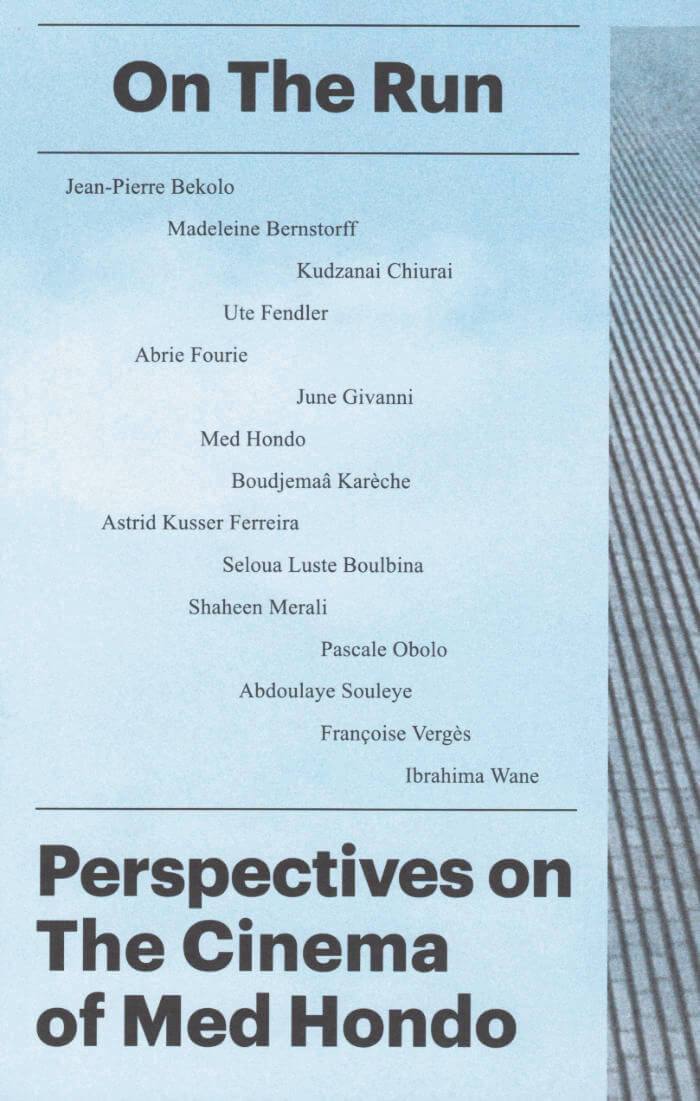
On the Run – Perspectives on the Cinema of Med Hondo
A tribute.
A pioneer of African cinema and author of an uncompromising, strong and diverse oeuvre, we have come to know and appreciate Med Hondo over the decades as one who simultaneously gazes, belligerently and attentively, sharply, passionately and ironically, deep into the past, precisely at the present, but also far into the future. On the Run, Perspectives on the Cinema of Med Hondo features contributions that pay tribute to Med Hondo's films. This publication examines Hondo's work, which is often focused on the production of history and its practice from an African perspective, taking into account the temporality of the narratives in his work.
Contributions by Jean-Pierre Bekolo, Madeleine Bernstorff, Kudzanai Chiurai, Ute Fendler, Abrie Fourie, June Givanni, Med Hondo, Boudjemaâ Karèche, Astrid Kusser Ferreira, Seloua Luste Boulbina, Shaheen Merali, Pascale Obolo, Abdoulaye Souleye, Françoise Vergès, Ibrahima Wane.
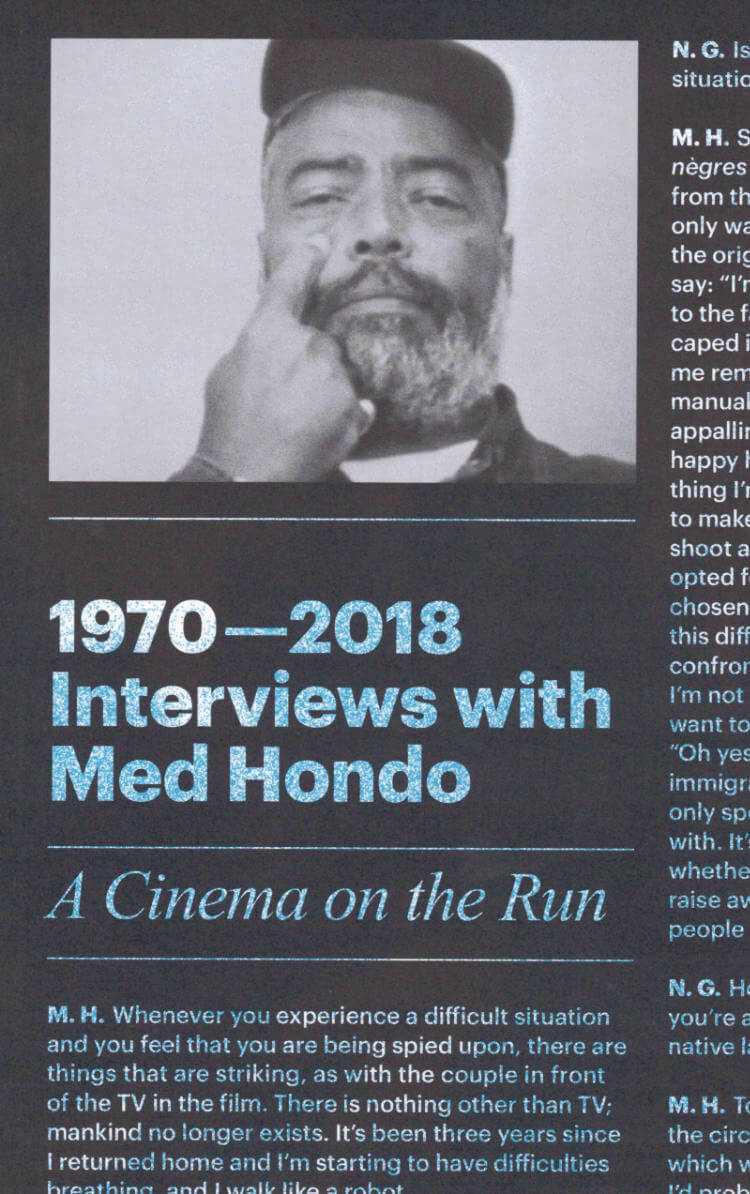
1970—2018 – Interviews with Med Hondo
Seventeen interviews conducted with Med Hondo over a period of almost half a century, most of the interviews originally published in French were translated into English.
To read Med Hondo opens us up to many perspectives: to his work and its time-historical contexts, to his interests and obsessions, to his standpoint with regard to the intertwining of politics, economics, and culture. Med Hondo describes the school of pronunciation until such point as the slightest accent is erased; he observes the insults immigrants in France have had to tolerate, and fuses their stories and histories with the present; he builds bridges to the Caribbean and to the Western Sahara, to Algeria and Burkina Faso, to Niger and Senegal, to South Africa and the USA. This publication aims to draw attention to Med Hondo's cinema and legacy.
The book originated in the long-term project Cours, cours, camarade, le vieux monde est derrière toi—Run, comrade, run, the old world is behind you—The Cinema of Med Hondo.
Franco-Mauritanian director, screenwriter, producer and actor, also known for his work in dubbing, Med Hondo (1936-2019) is one of the great figures of African cinema. His militant work denounces neo-colonialism, racism, the rupture between the peoples of Africa, immigration policies and the resulting social violence.

Cinema Diva #1
Laura Automme, Marine Forestier and 1 more
This publication takes the form of a cinema program, CINEMA DIVA # 1 describes and illustrates 4 movies. The texts are both poetical and critical, expressing two different views from women authors. Let's experiment the female gaze through old and current movies that you must see! Let's talk about women directors and more!
Texts : Marine Forestier & Aurora Desq.
Illustrations : Laura Automne

Another Gaze Journal 04
Including essays about Madeline Anderson, Lorenza Mazzetti, Laure Prouvost, Ben Rivers & Anocha Suwichakornpong, Agnieszka Holland’s Spoor, Susan Sontag’s filmmaking career, Storm De Hirsch, Zia Anger, Ashley Connor, Bruce LaBruce, Pina Bausch/Chantal Akerman, Magdalena Montezuma, Rebecca Horn, Anne Charlotte Robertson, Zhu Shengze, Beatriz Santiago Muñoz, Maya Da-Rin, Camila Freitas, Gong Li
An in-depth Afro-Brazilian roundtable with Tatiana Carvalho Costa, Janaina Oliveira, Everlane Moraes and Kênia Freitas; sections on Kira Muratova and Anne Charlotte Robertson; essays on subtitles, diffractive cinemas, ecocriticism/the anthropocene, literary adaptations, intimacy coordinators, strike on film, representing the internet,
Interviews with Betzy Bromberg, Zia Anger & Ashley Connor, Brett Story, Amandine Gay, Andrea Luka Zimmerman & Therese Henningsen
Experimental criticism from Kathryn Scanlan, Jen Calleja and Elissa Suh.
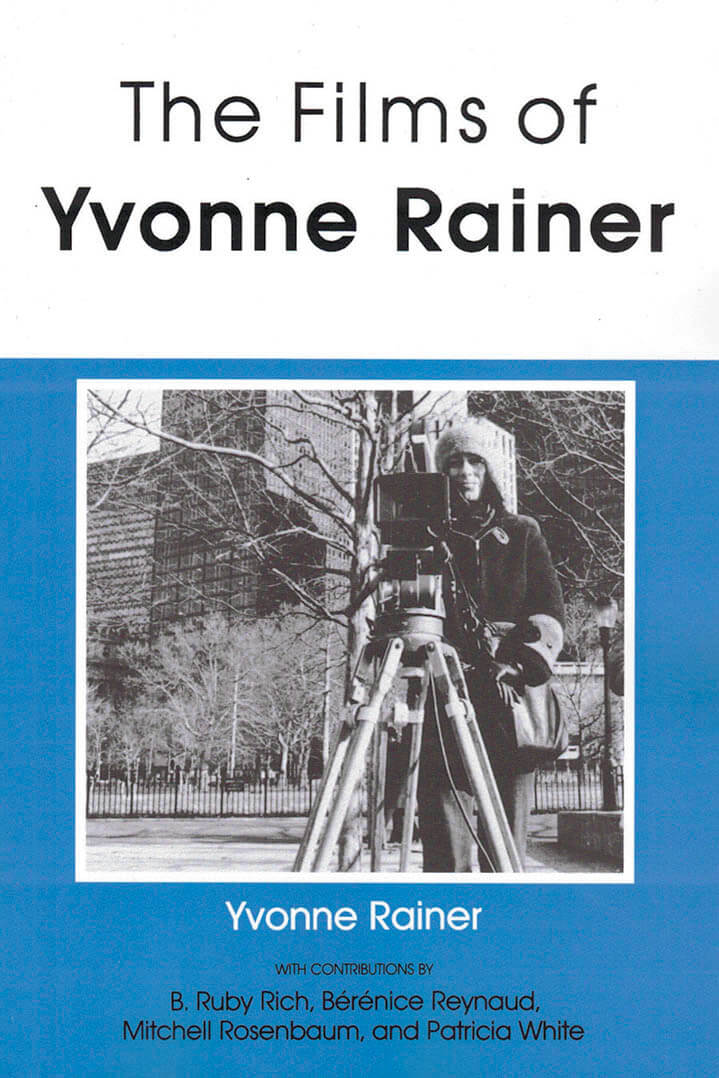
The Films of Yvonne Rainer
The scripts of Rainer's five films, presented here along with essays, an interview, and bibliography, demonstrate the evolution of her political consciousness as well as her creative engagement with the contemporary film and cultural scene. These texts challenge the illusionist and ideological presumptions of mainstream culture and cinema.
Film Scripts included:
Lives of Performers
Film About a Woman Who...
Kristina Talking Pictures
Journeys from Berlin/1971
The Man Who Envied Women

Programmed Melancholy
Gabriel Abrantes has been making a career in cinema; with numerous international exhibitions, he's been keeping prolific, with video installations, drawing, painting, and now also VR. This book, published by maat and Mousse, attests exactly this. A book that is predominantly visual and clearly structured, efficient in transposing a certain formal and conceptual attitude that runs through Abrantes's work into the book's aesthetic approach, expressing humour and irony visually within a relatively classical framework.
"The juxtaposition of references to art and cultural history with personal and socio-political commentary is a guiding thread throughout Programmed Melancholy." writes Emily Butler, in one of the essays included in this book (other texts are an interview with the artist and short essay by Rosa Lleó). Butler continues: "His works engage with our emotions, with a range of personal feelings, often humorous, potentially rousing ethical and political beliefs. Unstable, multi-faced, polysexual, his characters waver between expressing personal emotions and wider social, environmental and political concerns."
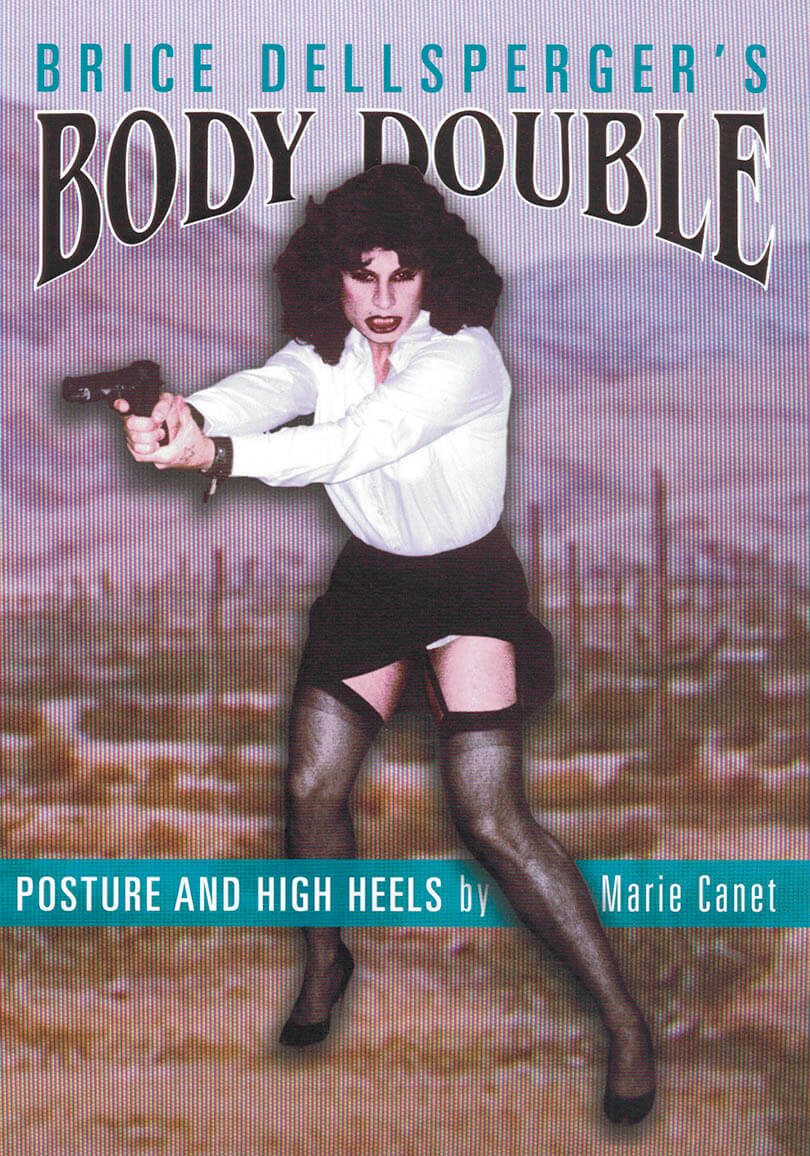
Body Double
Artist's book (an hallucinated portrait gallery of most of the characters created by Brice Dellsperger for his film remakes) / first substantive study of his work, with an essay by Marie Canet.
Brice Dellsperger's Body Double is the first monograph ever published on the artist's already cult film productions, with a long essay by art historian Marie Canet that addresses filmic remake, but also issues of models, gender politics, and representational chaos. Consisting in a large body of unpublished images, the book also invites the reader backstage—as in Kenneth Anger's Hollywood Babylon, after which this book is modeled—into the Dellspergian camp film factory, to get a closer look at the characters and personas that populate the Body Double series, and that are creations both of the artist and of his main performer and muse, Jean-Luc Verna.
Brice Dellsperger (born 1972 in Cannes, France, lives and works in Paris) pushes the boundaries of genre and gender. In his multifaceted reprises of iconic film sequences—all assembled under the generic title Body Double—the cineast and artist reenacts the selected scenes frame for frame and lets his “body doubles” perform all of the roles, be they male or female.
Brice Dellsperger has exhibited extensively in Europe and abroad, and began his well-known Body Double series in 1995. His work is in collections that include the Museum of Modern Art, Musée d'Art Moderne – Centre Pompidou, and the Nouveau Musée National de Monaco.
Available in French edition.

Shame Space
Diaries of an avatar: a Bible-style artist's book of writings by Martine Syms
A new artist's book by California-based artist Martine Syms (born 1988), Shame Space explores the possibilities of narrative and identity, collecting journal writings by the artist from 2015 to 2017 in which she attempts to capture her shadow self, alongside image stills from the video project Ugly Plymouths. The text entries form the voiceover of Mythiccbeing (pronounced "my thick being'), a "black, upwardly mobile, violent, solipsistic, sociopathic, gender-neutral femme" digital avatar who has iterated across several of Syms' recent exhibitions. In Syms' installations, Mythiccbeing manifests variously in video, audio and as an interactive chatbot that responds to the viewer's communications with messages and animations.
In Shame Space, the character's autofictional, diaristic commentary is gathered into 15 chapters. Its design updates the Bible format with its A5 size, embossed leather-textured cover and silver edge painting. The Ugly Plymouths still-image selection was coded using a programming script, such that the design, like the chatbot's SMS responses, is an exercise in machine automation.
Published Dec 2020
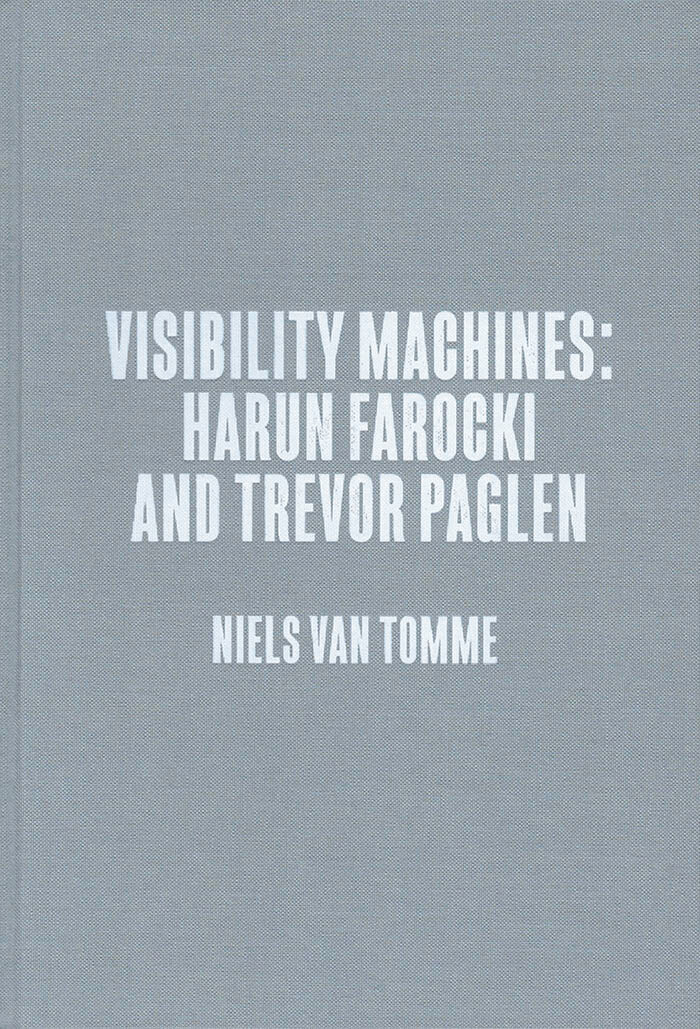
Center for Art, Design and Visual Culture
Visibility Machines: Harun Farocki and Trevor Paglen
Visibility Machines explores the unique roles that German filmmaker, video artist and author Harun Farocki (1944-2014) and American artist and author Trevor Paglen (born 1974) play as meticulous observers of global military operations. Investigating forms of surveillance, espionage and weaponry, Farocki and Paglen both examine the ways in which military activities transform and politicize our relationship to images and the realities they appear to represent.
The publication contains a number of newly commissioned essays by esteemed scholars who approach the work from diverse thematic perspectives, in addition to texts by Farocki and Paglen, as well as three exclusive visual essays exploring themes emerging from a dialogue between their work.

Kino/ Atelier - Program
With texts and contributions by Nicholas Vargelis, Kerstin Stakemeier, Steve Beck, Lis Rhodes, Leslie Bauer, Érik Bullot, C.Vanaik, VUE Committee, Shirley Clarke, Hilary Harris, Giuliana Bruno, Pier Paolo Pasolini, Peter Larsen, Elissa Suh, Straub-Huillet, Storm de Hirsch, Mark Fisher, Bruce Baillie, Rachel Haidu, Kai Althoff, Jennifer Reeves, Karl Holmqvist, Eros in Le Wind, Marie Menken and Jonas Raam.
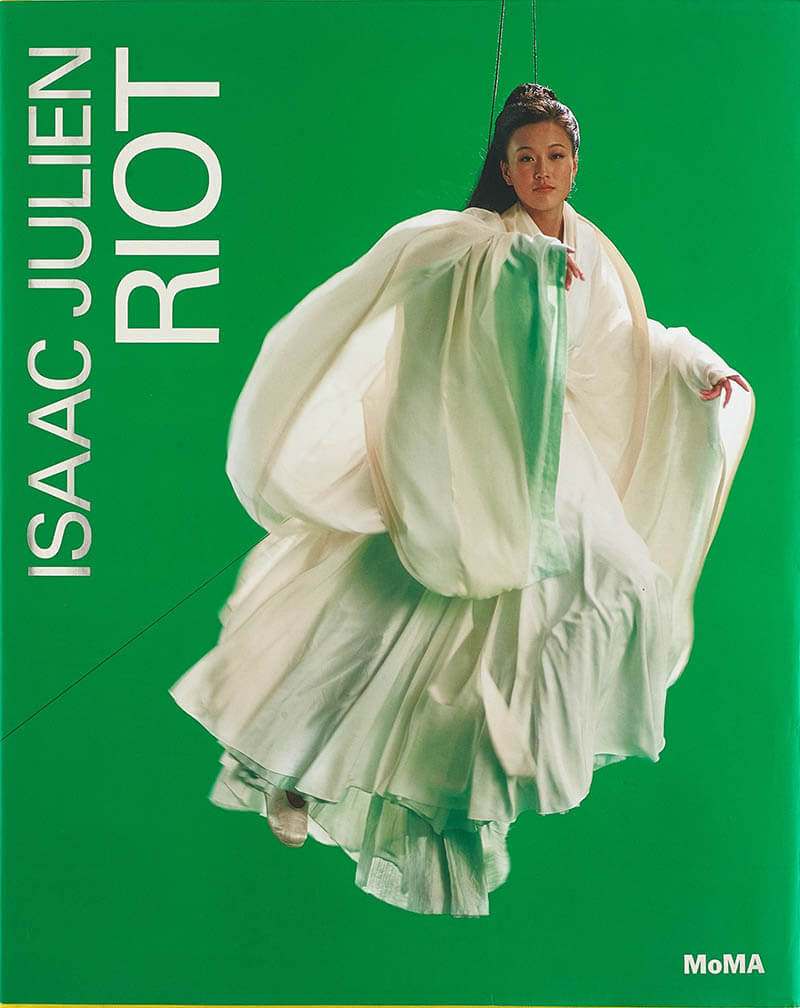
Riot
Riot is an intellectual biography of artist and filmmaker Isaac Julien (born 1960), looking at key moments in his career and discussing the influences that shaped them. Julien's trail-blazing career has moved across film and art, documentary, biography, narrative film and multi-screen installation, and has drawn on influences as disparate as silent cinema, cultural studies, Chinese myth and pirate radio culture. Riot is the first career-long overview on Julien, situating his work in the context of his personal and intellectual development: the friendships, mentors, night clubs, films, politics, records and the artworks that informed his practice. The backdrop to Julien's own story is a collage of some of the most important political and cultural events of the past 30 years: Thatcherism and the rise of neo-liberalism, the AIDS epidemic, punk rock, social riots, the globalization of the art market and the movement of filmmakers into the gallery.
With Texts by: Giuliana Bruno, Paul Gilroy, Stuart Hall, Bell Hooks, Kobena Mercer, Laura Mulvey and Mark Nash.
Published 2014
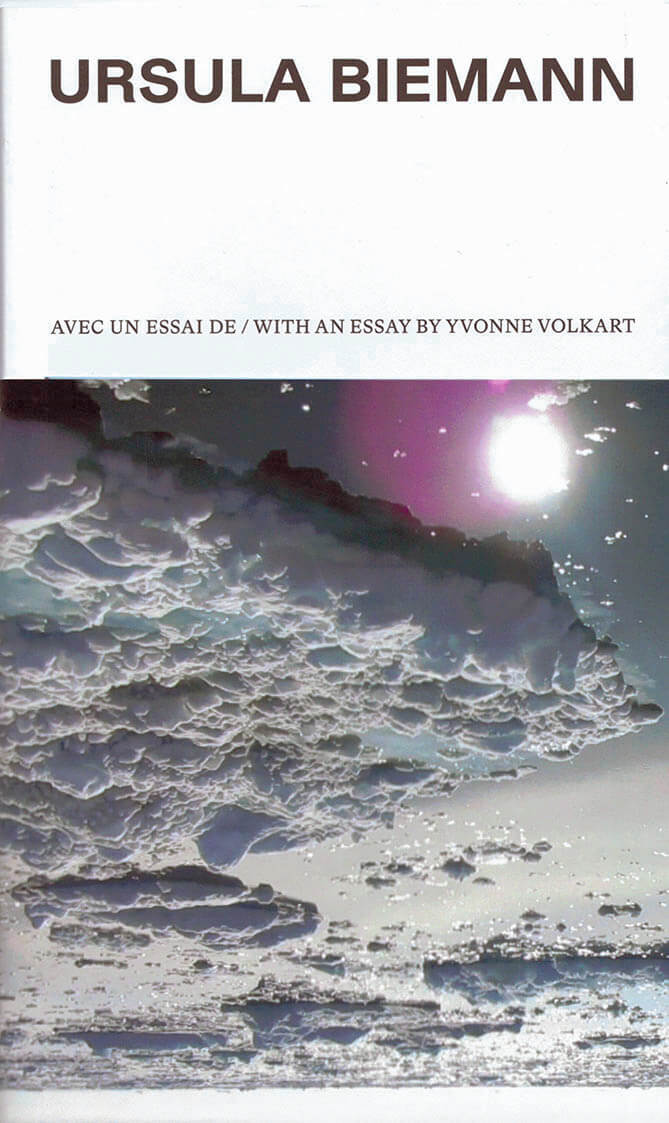
Ursula Biemann
A notebook based on Ursula Biemann's latest film, Acoustic Ocean, an expedition to the depths of the Arctic Ocean in search of interspecies communications.
32 p, ills colour, 14 x 23 cm, pb, French/English

For a Time
Published in conjunction with the exhibition For a Time Light Must Be Called Darkness. Lina Selander in collaboration with Oscar Mangione held at Argos, Centre for Art & Media, Brussels, 24.09.2017 - 17.12.2017.
About the exhibition:
For a Time Light Must Be Called Darkness features six video installations, most of them made in collaboration with Oscar Mangione. These works take us to Bredäng (a suburb in south-west Stockholm), Berlin, the West Bank, Pripyat and Chernobyl. All of these places are the occasion and the starting point for broader reflections about our present in relation to historical facts. Selander visits these sites and like an archaeologist digs in their past, their monuments, museums and archives. She looks for visual documents, focuses on details and analytically sketches new hypothesis. In this way, she tries to retrace hidden links between distant imageries, correspondences and analogies, in order to create new narratives. In her essayistic approach, Selander combines her own texts and footage along with still images, quotes and archive material. In this way a constant tension springs within these multiple-layered audiovisual works and reminds us that seeing is never an innocent act.

Foundlings
Foundlings, a video film, was shot near Wexford, in the south east of Ireland where she grew up. This visual poem without a particular narrative and full of autobiographical elements is set at a very slowed down pace. Floating images and heavy voices are central to the associative strategy that is at work here. The images allow one to listen to a hypnotic voice, while at the same time allowing the eyes to wander... to daydream... to travel over drawn out time. The images are country images, images of repetitive calm, the kind of calm one finds between awake and asleep. The speed of the sea sets the pace, regular yet irregular. The images are inhabited by people who cannot speak. Who are busy doing nothing, except passing time. Silent brothers and sisters of the sea.
The soundsculpture Unsaid, a joint work by Orla Barry and Portuguese artist Rui Chafes (1964), is very opposite to the film. The film is full of open spaces and bright colours. The sculpture is black, closed and claustrophobic and on top of that it is housed in a narrow tower five meters tall. The visitor has to take place on a rather unconventional chair and put his head in a closed off sphere, surrounding himself by darkness and leaving him with his own heartbeat. A voice addresses the visitor directly on highly intimate terms. The seating is hard and uncomfortable. One has to be strong to experience this piece that is a perpetual struggle between body and mind.
At the occassion of Barry’s show argos editions published Foundlings, a combined artist book and catalogue that can be ordered through argos. The book includes a DVD.
Orla Barry (1969) is an artist who centres her practice on language, written and spoken. Her work is strongly poetic and lyrical, crossing a wide variety of media. Barry was born in Ireland, and the rhythm of her phraseology, the pictorial and narrative vernacular on which she draws, somehow evokes her homeland’s topography, climate and literary heritage. At argos the artist presented two new works.